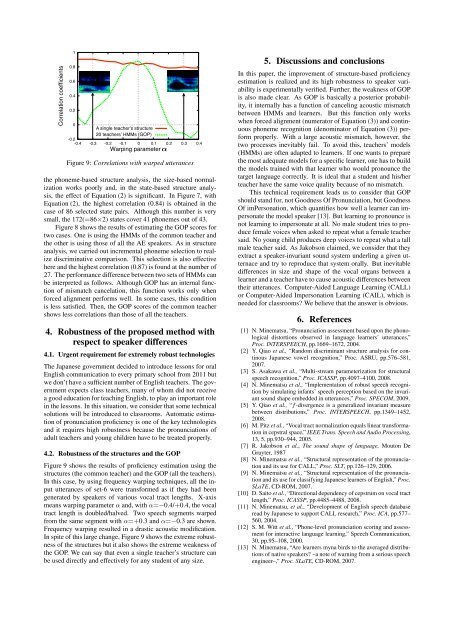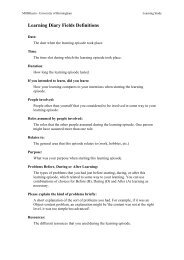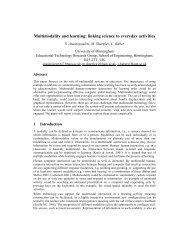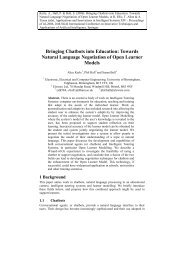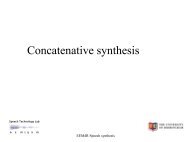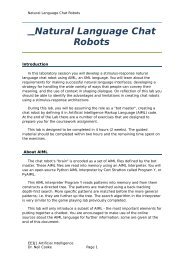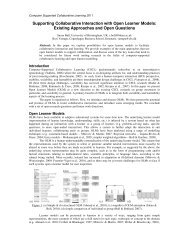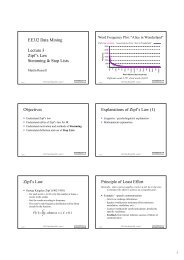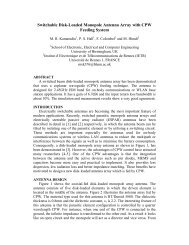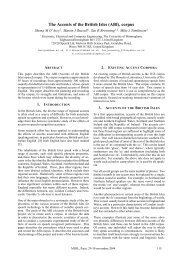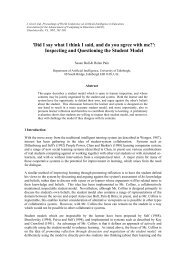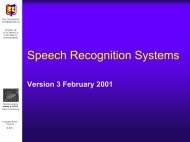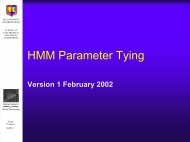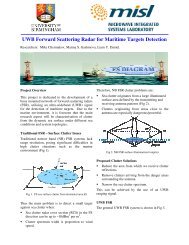Improved Structure-based Automatic Estimation of Pronunciation ...
Improved Structure-based Automatic Estimation of Pronunciation ...
Improved Structure-based Automatic Estimation of Pronunciation ...
Create successful ePaper yourself
Turn your PDF publications into a flip-book with our unique Google optimized e-Paper software.
Correlation coefficients<br />
1<br />
0.8<br />
0.6<br />
0.4<br />
0.2<br />
0<br />
A single teacher’s structure<br />
20 teachers’ HMMs (GOP)<br />
-0.2<br />
-0.4 -0.3 -0.2 -0.1 0 0.1 0.2 0.3 0.4<br />
Warping parameter®<br />
Figure 9: Correlations with warped utterances<br />
the phoneme-<strong>based</strong> structure analysis, the size-<strong>based</strong> normalization<br />
works poorly and, in the state-<strong>based</strong> structure analysis,<br />
the effect <strong>of</strong> Equation (2) is significant. In Figure 7, with<br />
Equation (2), the highest correlation (0.84) is obtained in the<br />
case <strong>of</strong> 86 selected state pairs. Although this number is very<br />
small, the 172(=86×2) states cover 41 phonemes out <strong>of</strong> 43.<br />
Figure 8 shows the results <strong>of</strong> estimating the GOP scores for<br />
two cases. One is using the HMMs <strong>of</strong> the common teacher and<br />
the other is using those <strong>of</strong> all the AE speakers. As in structure<br />
analysis, we carried out incremental phoneme selection to realize<br />
discriminative comparison. This selection is also effective<br />
here and the highest correlation (0.87) is found at the number <strong>of</strong><br />
27. The performance difference between two sets <strong>of</strong> HMMs can<br />
be interpreted as follows. Although GOP has an internal function<br />
<strong>of</strong> mismatch cancelation, this function works only when<br />
forced alignment performs well. In some cases, this condition<br />
is less satisfied. Then, the GOP scores <strong>of</strong> the common teacher<br />
shows less correlations than those <strong>of</strong> all the teachers.<br />
4. Robustness <strong>of</strong> the proposed method with<br />
respect to speaker differences<br />
4.1. Urgent requirement for extremely robust technologies<br />
The Japanese government decided to introduce lessons for oral<br />
English communication to every primary school from 2011 but<br />
we don’t have a sufficient number <strong>of</strong> English teachers. The government<br />
expects class teachers, many <strong>of</strong> whom did not receive<br />
a good education for teaching English, to play an important role<br />
in the lessons. In this situation, we consider that some technical<br />
solutions will be introduced to classrooms. <strong>Automatic</strong> estimation<br />
<strong>of</strong> pronunciation pr<strong>of</strong>iciency is one <strong>of</strong> the key technologies<br />
and it requires high robustness because the pronunciations <strong>of</strong><br />
adult teachers and young children have to be treated properly.<br />
4.2. Robustness <strong>of</strong> the structures and the GOP<br />
Figure 9 shows the results <strong>of</strong> pr<strong>of</strong>iciency estimation using the<br />
structures (the common teacher) and the GOP (all the teachers).<br />
In this case, by using frequency warping techniques, all the input<br />
utterances <strong>of</strong> set-6 were transformed as if they had been<br />
generated by speakers <strong>of</strong> various vocal tract lengths. X-axis<br />
means warping parameter α and, with α=−0.4/+0.4, the vocal<br />
tract length is doubled/halved. Two speech segments warped<br />
from the same segment with α=+0.3 and α=−0.3 are shown.<br />
Frequency warping resulted in a drastic acoustic modification.<br />
In spite <strong>of</strong> this large change, Figure 9 shows the extreme robustness<br />
<strong>of</strong> the structures but it also shows the extreme weakness <strong>of</strong><br />
the GOP. We can say that even a single teacher’s structure can<br />
be used directly and effectively for any student <strong>of</strong> any size.<br />
5. Discussions and conclusions<br />
In this paper, the improvement <strong>of</strong> structure-<strong>based</strong> pr<strong>of</strong>iciency<br />
estimation is realized and its high robustness to speaker variability<br />
is experimentally verified. Further, the weakness <strong>of</strong> GOP<br />
is also made clear. As GOP is basically a posterior probability,<br />
it internally has a function <strong>of</strong> canceling acoustic mismatch<br />
between HMMs and learners. But this function only works<br />
when forced alignment (numerator <strong>of</strong> Equation (3)) and continuous<br />
phoneme recognition (denominator <strong>of</strong> Equation (3)) perform<br />
properly. With a large acoustic mismatch, however, the<br />
two processes inevitably fail. To avoid this, teachers’ models<br />
(HMMs) are <strong>of</strong>ten adapted to learners. If one wants to prepare<br />
the most adequate models for a specific learner, one has to build<br />
the models trained with that learner who would pronounce the<br />
target language correctly. It is ideal that a student and his/her<br />
teacher have the same voice quality because <strong>of</strong> no mismatch.<br />
This technical requirement leads us to consider that GOP<br />
should stand for, not Goodness Of <strong>Pronunciation</strong>, but Goodness<br />
Of imPersonation, which quantifies how well a learner can impersonate<br />
the model speaker [13]. But learning to pronounce is<br />
not learning to impersonate at all. No male student tries to produce<br />
female voices when asked to repeat what a female teacher<br />
said. No young child produces deep voices to repeat what a tall<br />
male teacher said. As Jakobson claimed, we consider that they<br />
extract a speaker-invariant sound system underling a given utternace<br />
and try to reproduce that system orally. But inevitable<br />
differences in size and shape <strong>of</strong> the vocal organs between a<br />
learner and a teacher have to cause acoustic differences between<br />
their utterances. Computer-Aided Language Learning (CALL)<br />
or Computer-Aided Impersonation Learning (CAIL), which is<br />
needed for classrooms We believe that the answer is obvious.<br />
6. References<br />
[1] N. Minematsu, “<strong>Pronunciation</strong> assessment <strong>based</strong> upon the phonological<br />
distortions observed in language learners’ utterances,”<br />
Proc. INTERSPEECH, pp.1669–1672, 2004.<br />
[2] Y. Qiao et al., “Random discriminant structure analysis for continous<br />
Japanese vowel recognition,” Proc. ASRU, pp.576–581,<br />
2007.<br />
[3] S. Asakawa et al., “Multi-stream parameterization for structural<br />
speech recognition,” Proc. ICASSP, pp.4097–4100, 2008.<br />
[4] N. Minematsu et al., “Implementation <strong>of</strong> robust speech recognition<br />
by simulating infants’ speech perception <strong>based</strong> on the invariant<br />
sound shape embedded in utterances,” Proc. SPECOM, 2009.<br />
[5] Y. Qiao et al., “f-divergence is a generalized invariant measure<br />
between distributions,” Proc. INTERSPEECH, pp.1349–1452,<br />
2008.<br />
[6] M. Pitz et al., “Vocal tract normalization equals linear transformation<br />
in cepstral space,” IEEE Trans. Speech and Audio Processing,<br />
13, 5, pp.930–944, 2005.<br />
[7] R. Jakobson et al., The sound shape <strong>of</strong> language, Mouton De<br />
Gruyter, 1987<br />
[8] N. Minematsu et al., “Structural representation <strong>of</strong> the pronunciation<br />
and its use for CALL,” Proc. SLT, pp.126–129, 2006.<br />
[9] N. Minematsu et al., “Structural representation <strong>of</strong> the pronunciation<br />
and its use for classifying Japanese learners <strong>of</strong> English,” Proc.<br />
SLaTE, CD-ROM, 2007.<br />
[10] D. Saito et al., “Directional dependency <strong>of</strong> cepstrum on vocal tract<br />
length,” Proc. ICASSP, pp.4485–4488, 2008.<br />
[11] N. Minematsu, et al., “Development <strong>of</strong> English speech database<br />
read by Japanese to support CALL research,” Proc. ICA, pp.577–<br />
560, 2004.<br />
[12] S. M. Witt et al., “Phone-level pronunciation scoring and assessment<br />
for interactive language learning,” Speech Communication,<br />
30, pp.95–108, 2000.<br />
[13] N. Minematsu, “Are learners myna birds to the averaged distributions<br />
<strong>of</strong> native speakers –a note <strong>of</strong> warning from a serious speech<br />
engineer–,” Proc. SLaTE, CD-ROM, 2007.


